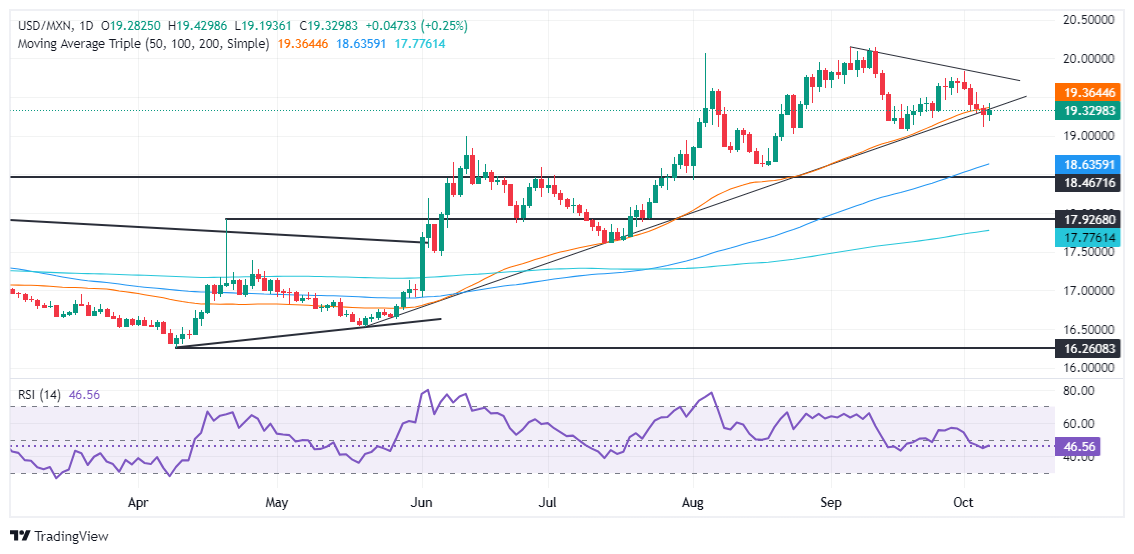- Mexican Peso slumps after hitting a low of 19.18, driven by risk-on sentiment favoring the US Dollar.
- Mexico's economic docket highlights an increase in the Jobless Rate to 3.0%, with focus turning to upcoming inflation data and Banxico’s September meeting minutes.
- US Nonfarm Payrolls for September exceeded expectations last Friday, adding 254K jobs as the Unemployment Rate fell to 4.1%.
The Mexican Peso begins the week on the back foot and falls some 0.20% against the Greenback amid a risk-on impulse that keeps the US Dollar trading near seven-week highs. Last week’s outstanding US Nonfarm Payrolls (NFP) data boosted the Mexican currency, but fears of an escalation of the Middle East conflict spurred flows to safe-haven currencies. The USD/MXN trades at 19.30 after bouncing off daily lows at 19.18.
On Friday, the US Bureau of Labor Statistics (BLS) revealed that over 254K people were added to the workforce in September, crushing estimates of 140K and August’s upwardly revised figure of 159K. Consequently, the Unemployment Rate edged lower from 4.2% to 4.1%.
Following the data, the USD/MXN dropped to a new monthly low of 19.10, though it closed near last Friday's highs, opening the door for a recovery.
Money markets trimmed the odds for a 50-basis-point (bps) rate cut by the US Federal Reserve (Fed) at the upcoming November meeting. Data from the Chicago Board of Trade (CBOT) via the December fed funds rate futures contract shows investors estimate 49 bps of easing by the Fed toward the end of 2024.
Data-wise, Mexico’s docket revealed that the Jobless Rate increased from 2.9% to 3.0%, while Automobile Production and Exports improved.
On Thursday, Mexico’s Supreme Court voted eight to three “to consider a constitutional challenge to the controversial judicial overhaul enacted last month,” which would allow the election of judges and Supreme Court magistrates via electoral vote.
Ahead of the week, Mexico’s economic docket will feature the release of Inflation data on Wednesday and the meeting minutes from the Bank of Mexico’s (Banxico) September gathering.
In the US, the schedule will feature many speeches by Fed officials, inflation data on the consumer and producer sides, and the University of Michigan (UoM) Consumer Sentiment for October.
Daily digest market movers: Mexican Peso pressured by strong US Dollar, risk aversion
- Banxico’s September poll of analysts and economists revealed that inflation expectations were reviewed to the downside, with headline prices down from 4.69% to 4.48% YoY. Underlying inflation is expected to hit 3.84% from 3.94%.
- The same survey showed the USD/MXN exchange rate is projected to end 2024 at 19.69, while Banxico’s main reference rate is foreseen to end at 10%.
- Mexico’s economy is foreseen to grow by 1.45% in 2024, lower than August’s 1.57%.
- Chicago Fed President Austan Goolsbee said that more job reports like this “will make me more confident we are settling in at full employment.” He said most Fed officials expect rates to decrease heavily over the next 18 months.
- Citi added its name to JPMorgan and Bank of America and changed its November Fed call from a 50 to 25 bps cut.
- Market participants have disregarded a 50 bps cut. The odds of a 25 bps cut are 83.5%, while the chances for holding rates unchanged are at 16.5%, according to the CME FedWatch Tool data.
USD/MXN technical outlook: Mexican Peso drops as USD/MXN jumps above 19.30
On Friday, I wrote, "The USD/MXN uptrend is doubtful as the pair cleared the 50-day Simple Moving Average (SMA) at 19.34, with sellers gathering momentum.” The exotic pair remains below that area, which could pave the way for further downside, despite solid gains on Monday.
In the short term, the Relative Strength Index (RSI) shifted bullish, though it remains in bearish territory. This opens the door for a leg-up before resuming its downtrend.
Therefore, the USD/MXN first resistance would be the 50-day SMA, followed by the 19.50 mark. A breach of the latter will expose the October 1 daily high of 19.82, ahead of 20.00. Up next would be the YTD peak of 20.22.
On the flip side, the USD/MXN's first support would be the September 24 swing low of 19.23. Once surpassed, the next demand area will be the September 18 daily low of 19.06, ahead of the psychological 19.00 figure.
Mexican Peso FAQs
The Mexican Peso (MXN) is the most traded currency among its Latin American peers. Its value is broadly determined by the performance of the Mexican economy, the country’s central bank’s policy, the amount of foreign investment in the country and even the levels of remittances sent by Mexicans who live abroad, particularly in the United States. Geopolitical trends can also move MXN: for example, the process of nearshoring – or the decision by some firms to relocate manufacturing capacity and supply chains closer to their home countries – is also seen as a catalyst for the Mexican currency as the country is considered a key manufacturing hub in the American continent. Another catalyst for MXN is Oil prices as Mexico is a key exporter of the commodity.
The main objective of Mexico’s central bank, also known as Banxico, is to maintain inflation at low and stable levels (at or close to its target of 3%, the midpoint in a tolerance band of between 2% and 4%). To this end, the bank sets an appropriate level of interest rates. When inflation is too high, Banxico will attempt to tame it by raising interest rates, making it more expensive for households and businesses to borrow money, thus cooling demand and the overall economy. Higher interest rates are generally positive for the Mexican Peso (MXN) as they lead to higher yields, making the country a more attractive place for investors. On the contrary, lower interest rates tend to weaken MXN.
Macroeconomic data releases are key to assess the state of the economy and can have an impact on the Mexican Peso (MXN) valuation. A strong Mexican economy, based on high economic growth, low unemployment and high confidence is good for MXN. Not only does it attract more foreign investment but it may encourage the Bank of Mexico (Banxico) to increase interest rates, particularly if this strength comes together with elevated inflation. However, if economic data is weak, MXN is likely to depreciate.
As an emerging-market currency, the Mexican Peso (MXN) tends to strive during risk-on periods, or when investors perceive that broader market risks are low and thus are eager to engage with investments that carry a higher risk. Conversely, MXN tends to weaken at times of market turbulence or economic uncertainty as investors tend to sell higher-risk assets and flee to the more-stable safe havens.
Information on these pages contains forward-looking statements that involve risks and uncertainties. Markets and instruments profiled on this page are for informational purposes only and should not in any way come across as a recommendation to buy or sell in these assets. You should do your own thorough research before making any investment decisions. FXStreet does not in any way guarantee that this information is free from mistakes, errors, or material misstatements. It also does not guarantee that this information is of a timely nature. Investing in Open Markets involves a great deal of risk, including the loss of all or a portion of your investment, as well as emotional distress. All risks, losses and costs associated with investing, including total loss of principal, are your responsibility. The views and opinions expressed in this article are those of the authors and do not necessarily reflect the official policy or position of FXStreet nor its advertisers. The author will not be held responsible for information that is found at the end of links posted on this page.
If not otherwise explicitly mentioned in the body of the article, at the time of writing, the author has no position in any stock mentioned in this article and no business relationship with any company mentioned. The author has not received compensation for writing this article, other than from FXStreet.
FXStreet and the author do not provide personalized recommendations. The author makes no representations as to the accuracy, completeness, or suitability of this information. FXStreet and the author will not be liable for any errors, omissions or any losses, injuries or damages arising from this information and its display or use. Errors and omissions excepted.
The author and FXStreet are not registered investment advisors and nothing in this article is intended to be investment advice.
Recommended content
Editors’ Picks

EUR/USD remains bid around 1.1200, USD melts on tariff concerns
EUR/usd maintains its bullish stance well in place on Thursday, reaching the 1.1200 barrier and beyond on the back of intense selling pressure on the US Dollar, fuelled by concerns over the impact of Trump's tariffs on the US economy.

GBP/USD settles around 1.2950 on weaker Dollar
GBP/USD advances markedly and extends its breakout of the 1.2900 hurdle amid global trade war jitters and a severe sell-off in the Greenback, which was exacerbated following news of 145% US tariffs on China.

Gold resumes record rally, reaches $3,175
Gold extended its record rally on fresh tariff-related headlines, trading as high as $3,175 a troy ounce in the American session. The White House confirmed 35% levies on Mexico and Canada, 145% on Chinese imports, resulting in a fresh round of USD selling and pushing XAU/USD further up.

Cardano stabilizes near $0.62 after Trump’s 90-day tariff pause-led surge
Cardano stabilizes around $0.62 on Thursday after a sharp recovery the previous day, triggered by US Donald Trump’s decision to pause tariffs for 90 days except for China and other countries that had retaliated against the reciprocal tariffs announced on April 2.

Trump’s tariff pause sparks rally – What comes next?
Markets staged a dramatic reversal Wednesday, led by a 12% surge in the Nasdaq and strong gains across major indices, following President Trump’s unexpected decision to pause tariff escalation for non-retaliating trade partners.

The Best brokers to trade EUR/USD
SPONSORED Discover the top brokers for trading EUR/USD in 2025. Our list features brokers with competitive spreads, fast execution, and powerful platforms. Whether you're a beginner or an expert, find the right partner to navigate the dynamic Forex market.




